Table of Contents
ToggleGoals of Beach Volleyball Court Lighting
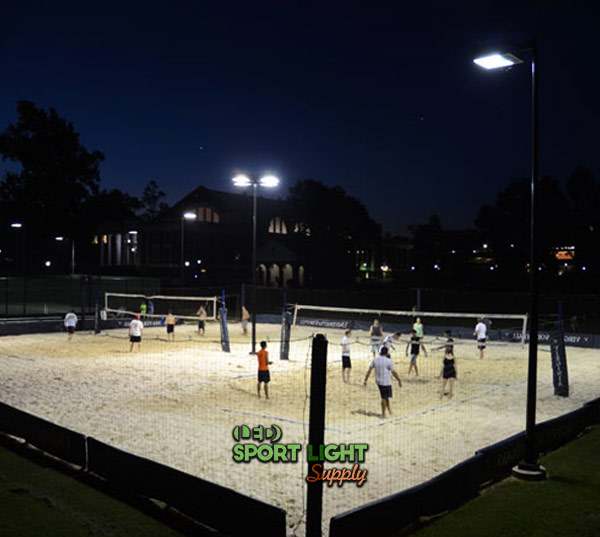
Optimizing Night Use of the Sand Volleyball Court
Beach volleyball court lighting plays a crucial role in extending the usability of the courts into the night. With proper lighting, matches can continue late into the evening, offering a convenient option for players who prefer to enjoy the game after sunset. This extended playtime not only benefits players but also provides volleyball clubs with an opportunity to increase revenue by keeping outdoor sand volleyball courts active longer. Additionally, LED floodlighting offers a cost-effective solution for illuminating indoor courts as well, ensuring that the sport can be enjoyed around the clock. Beach volleyball is a sport that thrives both day and night, and the right lighting is key to making this possible.
Enhancing Attackers’ Vision
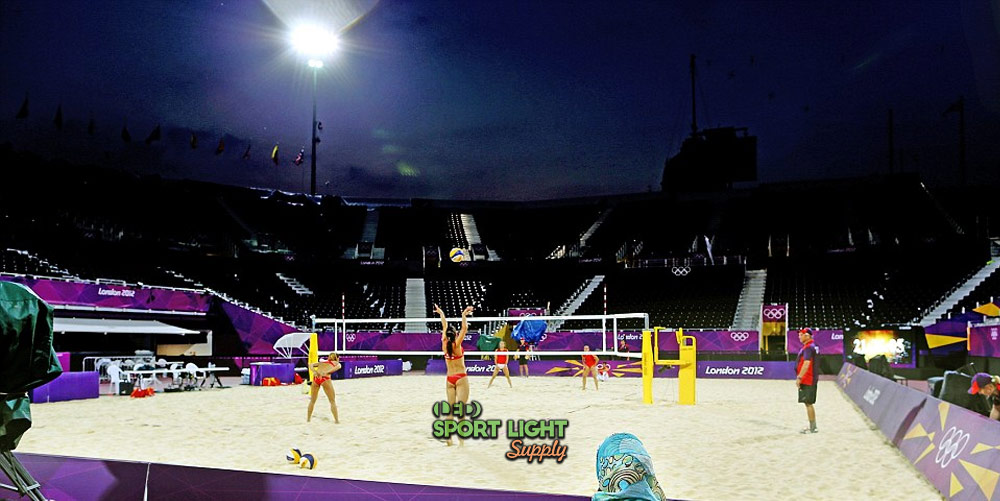
For attackers in volleyball, vision is paramount. The ability to focus and commit to a kill shot hinges on the quality of lighting. When an attacker jumps to hit the ball, factors such as illuminance and glare play a critical role. The correct lighting layout is essential in ensuring that players can perform at their best. Key elements of a successful lighting design include:
| Technical Aspect | Importance |
|---|---|
| Suitable Light Level | Ensures that the court is adequately illuminated for optimal gameplay. |
| Uniform Light Distribution | Provides consistent lighting across the court, reducing shadows and dark spots. |
| Glare-Free Light Sources | Prevents distractions and discomfort, allowing players to focus on the game. |
| Vertical Angles | Ensures that light is directed where it is most needed, enhancing visibility. |
Both indoor and outdoor lighting systems are designed to keep players at the center of the action. Every detail, from the sand to the volleyball net, must be tailored to help players perform at their peak, and the lighting is no exception.
Creating an Atmosphere for Spectators
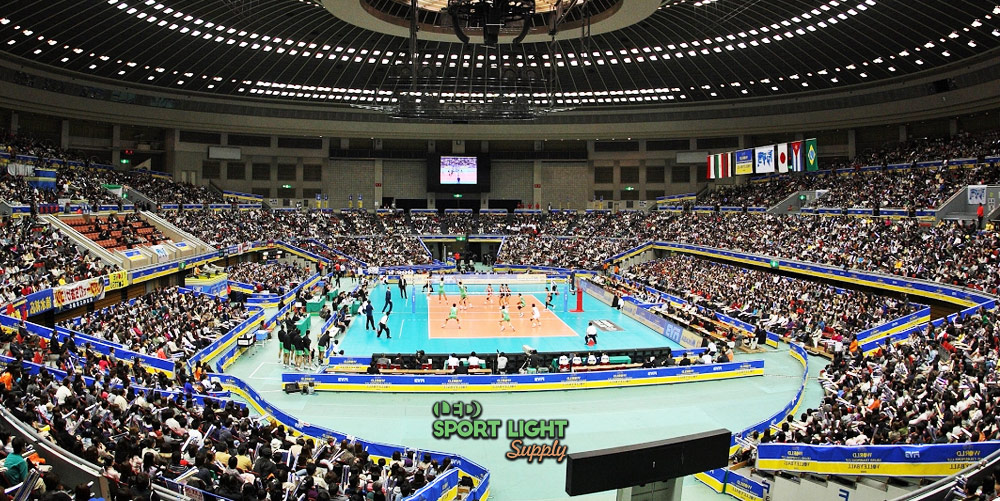
Spectators are an integral part of the beach volleyball experience, whether they are watching from the stands or on television. The right lighting design not only enhances the players’ performances but also creates an engaging atmosphere for the audience. Proper illuminance ensures that spectators can fully enjoy the game, and various technical aspects of the lighting contribute to this experience:
| Technical Consideration | Benefit |
|---|---|
| CRI (Color Rendering Index) | Ensures that colors appear realistic and vibrant, enhancing the viewing experience. |
| Flicker-Free Lighting | Provides smooth, uninterrupted broadcasts, ideal for televised matches. |
| IP Rating | Ensures the lighting system can withstand brief rain showers, maintaining performance. |
A well-designed lighting layout allows fans to savor each point, particularly during the most intense moments of the match.
Maximizing Sponsorship Opportunities
From a management perspective, a well-lit sand volleyball court is a valuable asset, especially when it comes to attracting sponsors. High-quality lighting not only improves the overall attractiveness of the venue but also increases the visibility of sponsorship ads, making the court more appealing to potential sponsors. In national and international tournaments such as AVP, enhanced lighting can lead to increased sponsorship opportunities, as sponsors seek to place their messages and products in the spotlight. The better the lighting, the greater the exposure, and the higher the likelihood of positive associations with the sponsors’ brands or services.
Best Lighting for Outdoor Beach Volleyball Courts
Flood Lights
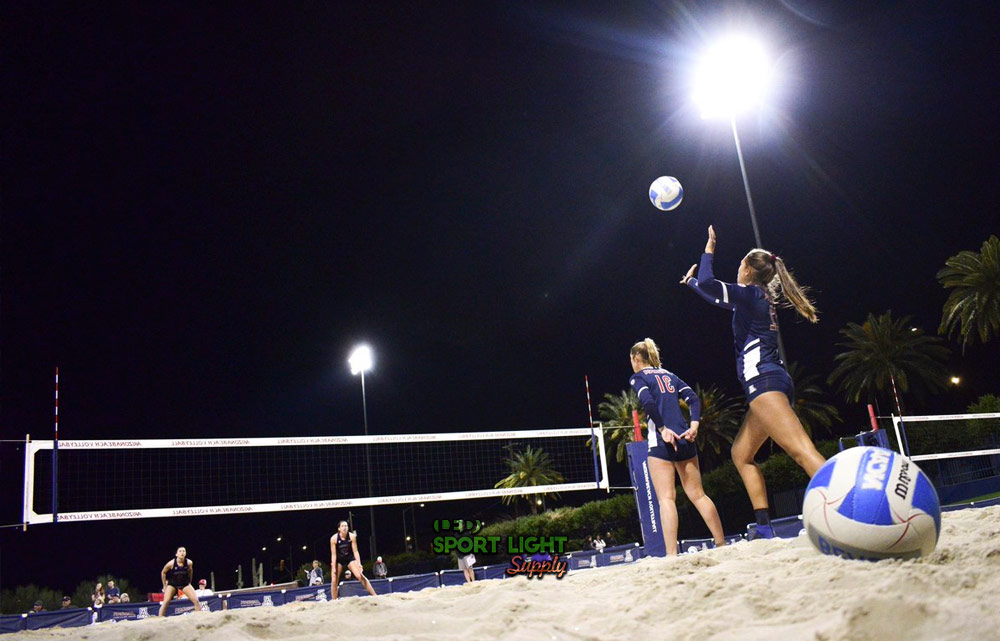
High mast floodlighting stands out as the optimal solution for illuminating outdoor sand volleyball courts. Given the potential for matches to extend into the night, especially with the rally and sideout scoring systems, reliable and effective lighting is essential. Floodlights, typically consisting of a standard LED projector and a durable lamp holder, are designed to withstand the outdoor elements, particularly on sandy beaches. These lights are commonly encased in dust- and water-proof housings, ensuring they remain functional even in harsh conditions.
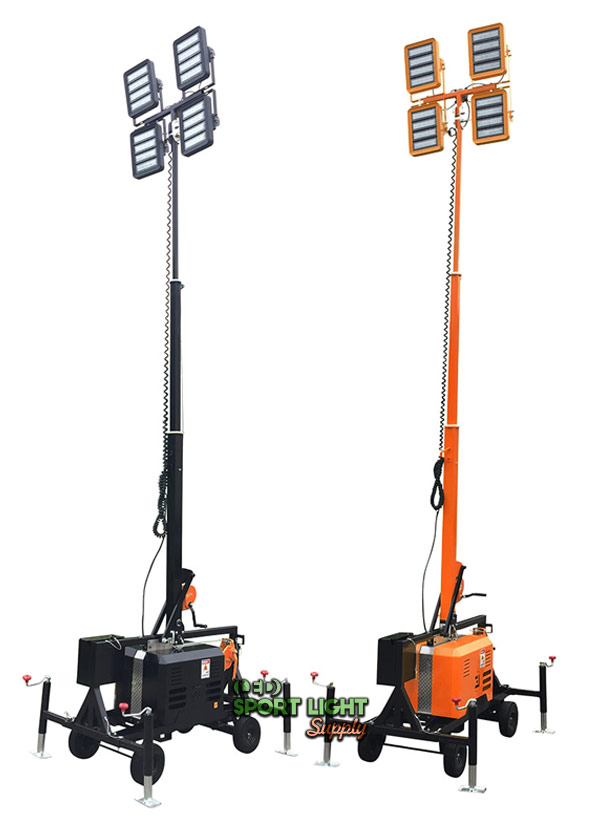
Portable Light Towers
Portable light towers offer a versatile and temporary lighting solution for beach volleyball courts. Among the various options, solar-powered models are particularly advantageous due to their energy independence. Equipped with a photovoltaic panel and a battery, these towers provide lighting without the ongoing costs associated with traditional power sources. Their portability allows them to be positioned strategically, such as near the sidelines or on a dedicated platform, ensuring optimal lighting coverage. The features that set portable light towers apart include:
| Feature | Benefit |
|---|---|
| Telescopic Lamp Post | Allows for adjustable height to cover different areas of the court. |
| Generator | Provides a backup power source, ensuring continuous lighting even in low-light conditions. |
| Solar Panels | Offers a sustainable and cost-effective power solution. |
| Trailer | Facilitates easy transportation and setup. |
| Wheels | Enhances mobility, allowing the tower to be moved as needed. |
| Safety Chains | Ensures stability and security, especially in windy conditions. |
Indoor Sand Volleyball Court Lighting Options
High Bay Lights
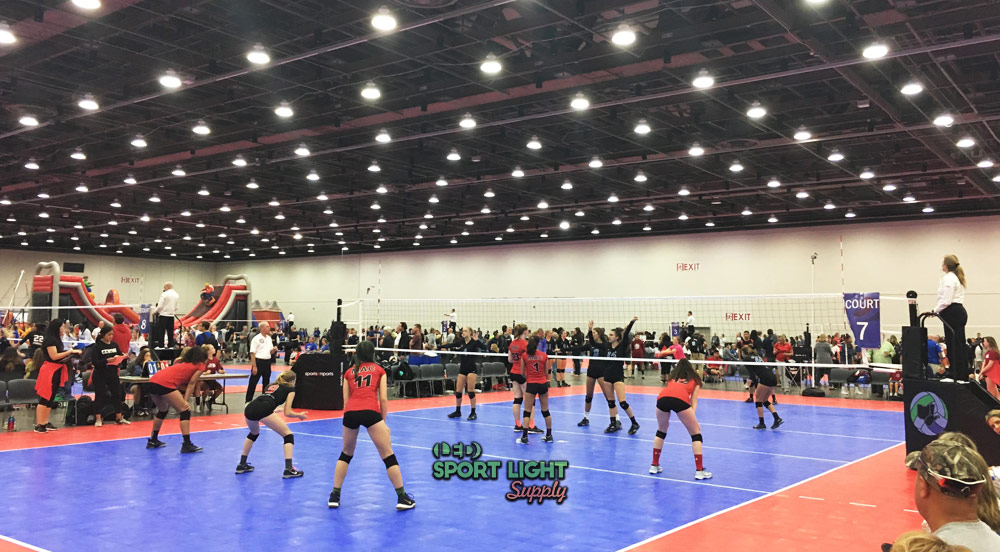
High bay lights are the preferred choice for indoor sand volleyball courts, particularly in venues with high ceilings. These lights are equipped with LED light sources and are designed to accommodate ceiling heights of over 20 feet (6 meters). Unlike low bay lights, high bay lights have lenses that focus the light downward, reducing the risk of interference from a high free ball. Their placement ensures minimal obstruction while providing ample illumination across the court.
Linear Lights
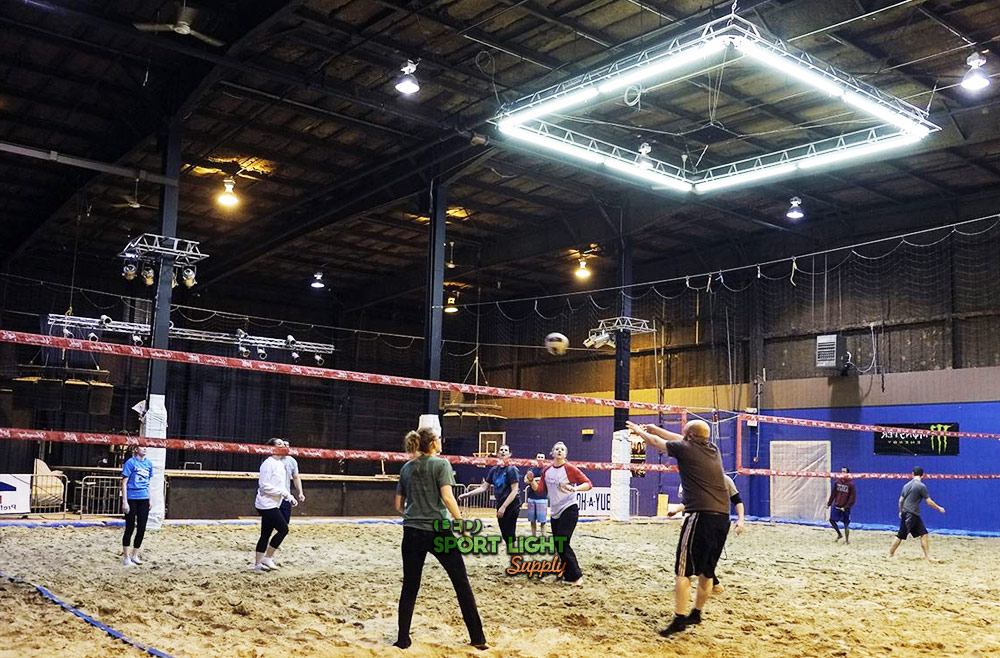
Linear lights offer a creative and space-efficient solution for indoor volleyball court lighting. These LED lights can be arranged in various patterns to enhance both the court and the spectator areas. When combined with high bay lights, they create a dynamic and visually appealing atmosphere. Linear lights are particularly effective during timeouts and team side switches, adding an element of excitement to the venue. Furthermore, they are a cost-effective way to ensure that televised events are presented in the best possible light, turning an ordinary court into a captivating scene of action.
Outdoor Beach Volleyball Court Lighting Design
Lux and Footcandle Levels Required
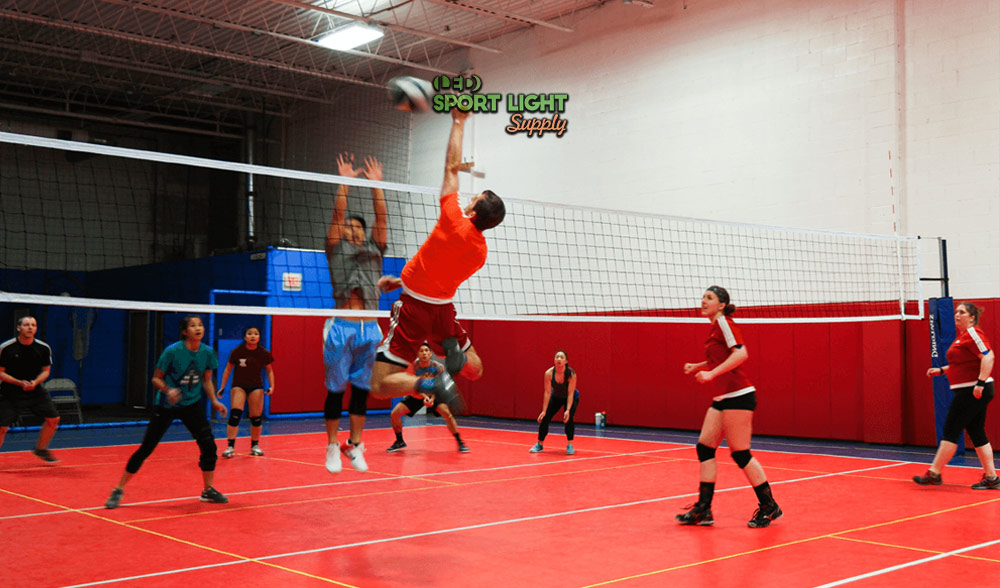
Beach volleyball is best enjoyed under the right lighting conditions, which vary depending on the level of play. The required lux levels for different purposes are as follows:
| Usage Type | Recommended Lux Level |
|---|---|
| Recreational Use | 150 to 300 lux |
| College Lighting Design/Training | 300 to 500 lux |
| National/International Tournaments | 1,000 to 2,000 lux |
The lux level ensures efficient illuminance by measuring the amount of light reaching the court’s surface. This consistency in light intensity is crucial for optimal playability across the entire volleyball court. While lux is a common unit of measurement, foot-candles (fc) may also be used, with 1 foot-candle equivalent to 10.76 lux. For accurate lux readings, professional equipment is required, and volleyball associations may specify different lux levels depending on the event or championship.
Lighting Uniformity
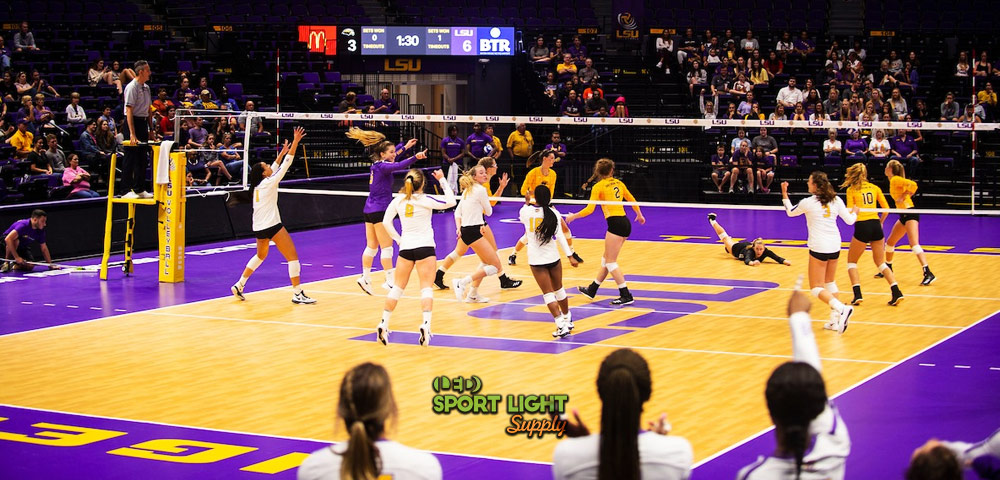
Ensuring even illumination across the volleyball court is critical for meeting lighting requirements. The lighting uniformity ratio, which typically ranges from 0.5 to 0.7, is calculated by dividing the lowest lux reading by the highest lux reading after the court has been divided into a grid. This uniformity is essential for providing consistent lighting conditions, helping players maintain their performance levels regardless of their position on the court.
Sea-Waterproof Lighting for a Beach Volleyball Court
Beach volleyball courts located near the sea face unique challenges due to their proximity to water. To protect the floodlight casings from frequent rain showers and storm surges, waterproof protection is essential. Lights with an IP rating of IP65 to IP68 are commonly used, with IP68 offering the highest level of protection and durability. The IP rating system measures the light’s resistance to liquid ingress, with the second digit indicating the level of protection—from zero, indicating no protection, to nine, indicating resistance to hot, pressurized water for extended periods.
Dust-Proof Protection
Sand and dust can easily enter and damage lighting fixtures, so using dust-proof and dust-resistant casings is crucial. The same IP code that governs waterproofing also applies to dust protection. The first digit of the IP rating reflects solid particle protection, with the highest rating (six) indicating a dust-tight casing. Therefore, installing IP65 to IP68-rated LED lights is imperative for outdoor volleyball court lighting systems to ensure longevity and performance.
Flicker-Free Lighting
The evolution of LED technology has raised the standard for high-end lighting products, particularly regarding flicker-free performance. Flickering can negatively affect both the perception of light and the quality of live broadcasts or recordings of beach volleyball matches. Modern broadcasting requires flicker-free lights to deliver the best viewing experience, making them essential for any facility hosting televised events.
Glare-Free Lighting
Anti-glare micro-structured lenses and optics have become a standard in modern LED lights, significantly reducing glare without diminishing luminous flux. This innovation benefits not only the players, who can perform without being dazzled but also the referees, who rely on clear vision to make accurate calls. For example, glare-free lighting helps referees avoid misjudgments, such as mistaking a clean hit for a double due to brief glimmer effects.
2-Pole or 4-Pole Layout
The placement of LED light fixtures and poles is crucial for achieving optimal lighting on a sand volleyball court. Two common layouts are widely used:
| Layout Type | Description | Benefits |
|---|---|---|
| 2-Pole Layout | 1 pole at the center of each sideline | Simplified installation with sufficient coverage |
| 4-Pole Layout | 2 poles per sideline | Eliminates shadows by providing light from four directions |
The pole layout directly impacts the efficiency of the lighting angles. Although the 4-pole layout is preferable for high-level competitions due to its ability to eliminate shadows, custom layouts can also be developed to accommodate specific court conditions, such as sand layers or other obstacles that may hinder standard pole installations.
Indoor Sand Volleyball Court Lighting Design and Layout
Direct or Indirect Lighting
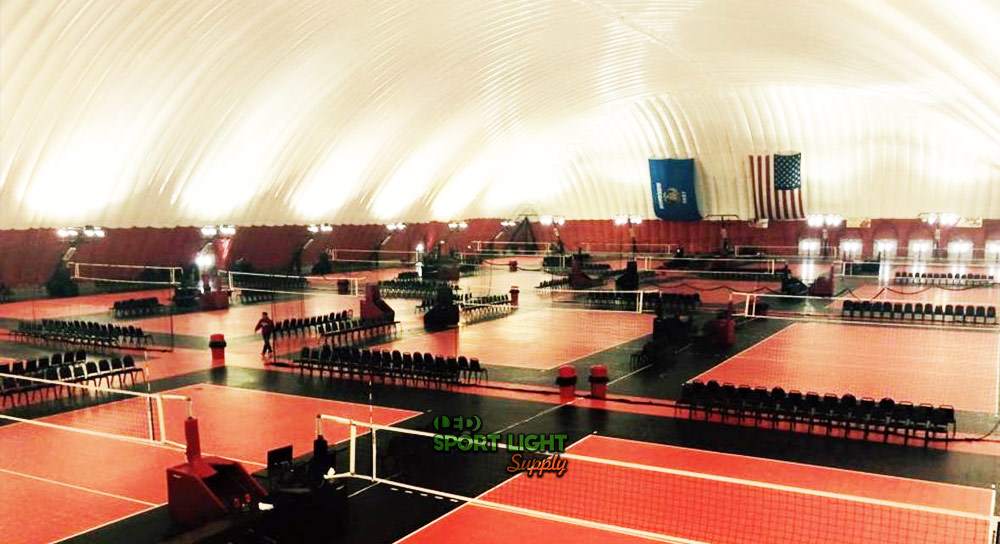
When designing the lighting for an indoor sand volleyball court, the choice between direct and indirect lighting plays a significant role in both the aesthetic appeal and functional performance of the venue.
Indirect Lighting
Indirect lighting, where light is reflected off surfaces rather than directed straight onto the court, offers higher lighting uniformity across the playing area. This method distributes light more evenly, reducing harsh shadows and creating a softer, more visually appealing environment. However, this approach tends to be more power-consuming, which may deter some indoor volleyball court owners who prioritize cost-efficiency. Despite the higher energy consumption, indirect lighting makes a striking first impression and adds a layer of sophistication and comfort to the arena.
Direct Lighting
Direct lighting involves fixtures that point light directly downward onto the court. This method is generally more energy-efficient and simpler to implement, making it a common choice for indoor sports facilities. However, relying solely on direct lighting can lead to uneven illumination, with potential hotspots and areas of shadow.
Optimal Solution
A balanced combination of direct and indirect lighting can enhance both the functionality and aesthetics of the indoor space. This blend provides adequate lighting for gameplay while also improving the visual appeal of the venue, making it both practical and inviting.
Spacing Between High Bay Flood Lights
The spacing between high bay flood lights is a critical aspect of lighting design that directly affects the uniformity and intensity of illumination on the court. Proper spacing ensures that the light covers the entire playing area without leaving dark spots or over-lit areas.
Recommended Spacing
High bay flood lights should typically be spaced 2 to 4 meters apart. The exact distance depends on factors such as the ceiling height and the beam angle of the lights.
Beam Angle Considerations
Manufacturers provide detailed specifications for their lighting products, including one or more beam angles. High bay lights are commonly available with either a wide beam angle (around 120 degrees) or a narrow one (around 50 degrees). The chosen beam angle will influence how far apart the lights should be placed. For example, lights with a wider beam angle can be spaced further apart, while those with a narrower beam angle need to be placed closer together to avoid uneven lighting.
Ceiling Height
The ceiling height of an indoor sand volleyball court is another crucial factor in ensuring proper lighting and gameplay conditions.
Minimum Height Requirement
The ceiling should be at least 20 feet (6 meters) high to accommodate standard volleyball play. If the ceiling is too low, it can interfere with the game, especially when players serve or spike the ball. A lower ceiling could result in the ball hitting the roof, disrupting the flow of the game and detracting from the overall experience.
Impact on Gameplay
A ceiling that meets or exceeds the 20-foot minimum height ensures that players have ample space for serves, spikes, and volleys without the risk of the ball hitting the ceiling. This height is also necessary to accommodate the high bay lights and ensure that they are positioned effectively to light the entire court without obstructing gameplay.
Benefits of Replacing Metal Halide, Halogen, or Mercury Vapor Sand Volleyball Court Lights with LED
LEDs Provide Superior Brightness and Energy Efficiency
Traditional light sources, such as metal halide, halogen, and mercury vapor lamps, have posed significant challenges for those installing beach volleyball lighting systems. These lights tend to overheat, requiring careful calculation of installation height to prevent burns from close proximity. However, LED lights have revolutionized this aspect of lighting. Not only do LEDs emit brighter light while operating at lower temperatures, but they also consume significantly less power. This efficiency allows for a safer, more comfortable environment on the court.
Long-Lasting LED Products
LED-based lighting fixtures are known for their exceptional lifespan. A stable voltage input, managed by an integrated chip, ensures the longevity of LEDs. Most LED sand volleyball court lights can last over 100,000 hours without faults, making them a superior choice compared to traditional light sources. In contrast, halogen bulbs often fail before reaching 6,000 hours due to overheating, and mercury vapor lamps, although they can last up to 25,000 hours, contain hazardous compounds and emit ultraviolet radiation. Metal halide lights share similar risks. On the other hand, LEDs offer a safe, long-lasting lighting solution.
Reduced Maintenance Costs
HID bulbs, such as metal halide and mercury vapor lamps, often require frequent maintenance due to issues like overwattage, overcurrent operation, and capacitor failures. These traditional light sources demand periodic and sometimes extraordinary maintenance to ensure proper operation. In contrast, LED lights have a much simpler design and rarely fail unexpectedly. They are less susceptible to overheating and other problems that typically lead to maintenance routines, resulting in significant savings on maintenance costs.
Color-Changing Capabilities
One of the unique features of LED lights is their ability to change color. This applies to both multi-color (RGB) and standard white lights. With dedicated software, you can adjust the color of RGB lights or vary the color temperature of white lights to simulate different times of the day. Most LED lights offer a standard color temperature of 5,500 K to mimic daylight, but you can also choose a more bluish or yellowish hue to meet players’ preferences, enhancing the overall experience on the court.
Versatile Lighting Control
LED lighting systems support DMX/DALI control, allowing for the grouping or individual addressing of lights. This makes it easier to switch lights on or off across different sand volleyball courts. Additionally, LED lights often come with a timing function, further increasing operational convenience. This versatile control system simplifies cable management, reducing the amount of copper needed beneath the sand near beach volleyball events and spectator areas.
Factors Determining the Cost of Sand Volleyball Court Lighting
Lux Level Required for the Competition
The cost of sand volleyball court lighting is significantly influenced by the required lux level, which varies depending on the level of competition. Higher lighting requirements demand more advanced lighting systems, making them more expensive. For recreational purposes, the lighting cost typically ranges between $300 and $800 per sand volleyball court. However, if you plan to host tournaments, it is crucial to consider all the potential variables that could affect the overall cost, including the level of illumination needed for competitive play.
Size of the Beach Volleyball Facility
The size of the sand volleyball facility directly impacts the running costs of the lighting system. Larger facilities, whether indoor or outdoor, especially those with multi-sport pitches, may require a more comprehensive lighting control system to adjust the lighting profile quickly and efficiently. This need for versatility in lighting control contributes to the overall cost, as larger areas require more lights and sophisticated management systems to ensure consistent illumination across the playing field.
Height of the Sand Volleyball Court Light Pole
The height of the light poles is another critical factor in determining the cost of sand volleyball court lighting. Taller poles tend to increase light loss, meaning that more light fixtures are needed to maintain the desired lux levels. Professionals use specialized software to calculate the light loss factor for each pole layout. By measuring the decrease in light intensity from the source, they can determine the necessary adjustments, including adding more light fixtures and luminaires to counteract the loss. This careful calculation helps ensure the lighting system meets the required standards, but it also adds to the overall cost.
Choice of Light Source
The type of light source used in the lighting system is a significant factor in the overall cost. LED lights are more expensive than traditional HID or mercury vapor lamps, but they offer a longer lifespan and lower energy consumption, making them a worthwhile investment in the long run. While traditional lamps are cheaper initially, they consume more energy and require frequent maintenance, leading to higher ongoing costs. In contrast, LED lights provide a functional and reliable lighting system for both outdoor and indoor sand volleyball courts. They are also more durable, withstanding time and adverse weather conditions better than other alternatives. This makes LED lights a key component in any smart investment plan for sand volleyball facilities.
Conclusion
High-quality lighting not only extends playing hours into the night but also enhances the performance of players, improves spectator enjoyment, and creates valuable sponsorship opportunities. The use of advanced LED technologies, such as floodlights and portable light towers, ensures efficient, durable, and visually appealing lighting solutions for both indoor and outdoor courts. Whether upgrading from traditional lighting or installing new systems, the benefits of modern LED lighting, including superior brightness, energy efficiency, and reduced maintenance costs, make it the optimal choice for any beach volleyball venue.
